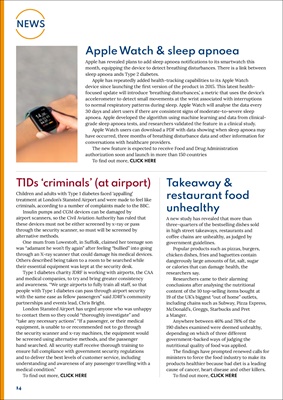
14
NEWS
Apple Watch & sleep apnoea
Apple has revealed plans to add sleep apnoea notifications to its smartwatch this
month, equipping the device to detect breathing disturbances. There is a link between
sleep apnoea ands Type 2 diabetes.
Apple has repeatedly added health-tracking capabilities to its Apple Watch
device since launching the first version of the product in 2015. This latest healthfocused
update will introduce 'breathing disturbances,' a metric that uses the device's
accelerometer to detect small movements at the wrist associated with interruptions
to normal respiratory patterns during sleep. Apple Watch will analyse the data every
30 days and alert users if there are consistent signs of moderate-to-severe sleep
apnoea. Apple developed the algorithm using machine learning and data from clinicalgrade
sleep apnoea tests, and researchers validated the feature in a clinical study.
Apple Watch users can download a PDF with data showing when sleep apnoea may
have occurred, three months of breathing disturbance data and other information for
conversations with healthcare providers.
The new feature is expected to receive Food and Drug Administration
authorization soon and launch in more than 150 countries
To find out more, CLICK HERE
T1Ds 'criminals' (at airport)
Children and adults with Type 1 diabetes faced 'appalling'
treatment at London's Stansted Airport and were made to feel like
criminals, according to a number of complaints made to the BBC.
Insulin pumps and CGM devices can be damaged by
airport scanners, so the Civil Aviation Authority has ruled that
these devices must not be either screened by x-ray or pass
through the security scanner, so must will be screened by
alternative methods.
One mum from Lowestoft, in Suffolk, claimed her teenage son
was "adamant he won't fly again" after feeling "bullied" into going
through an X-ray scanner that could damage his medical devices.
Others described being taken to a room to be searched while
their essential equipment was kept at the security desk.
Type 1 diabetes charity JDRF is working with airports, the CAA
and medical companies, to try and bring greater consistency
and awareness. "We urge airports to fully train all staff, so that
people with Type 1 diabetes can pass through airport security
with the same ease as fellow passengers" said JDRF's community
partnerships and events lead, Chris Bright.
London Stansted Airport has urged anyone who was unhappy
to contact them so they could "thoroughly investigate" and
"take any necessary actions". "If a passenger, or their medical
equipment, is unable to or recommended not to go through
the security scanner and x-ray machines, the equipment would
be screened using alternative methods, and the passenger
hand searched. All security staff receive thorough training to
ensure full compliance with government security regulations
and to deliver the best levels of customer service, including
understanding and awareness of any passenger travelling with a
medical condition."
To find out more, CLICK HERE
Takeaway &
restaurant food
unhealthy
A new study has revealed that more than
three-quarters of the bestselling dishes sold
in high street takeaways, restaurants and
coffee chains are unhealthy, as judged by
government guidelines.
Popular products such as pizzas, burgers,
chicken dishes, fries and baguettes contain
dangerously large amounts of fat, salt, sugar
or calories that can damage health, the
researchers say.
Researchers came to their alarming
conclusions after analysing the nutritional
content of the 10 top-selling items bought at
19 of the UK's biggest "out of home" outlets,
including chains such as Subway, Pizza Express,
McDonald's, Greggs, Starbucks and Pret
a Manger.
Anywhere between 46% and 78% of the
190 dishes examined were deemed unhealthy,
depending on which of three different
government-backed ways of judging the
nutritional quality of food was applied.
The findings have prompted renewed calls for
ministers to force the food industry to make its
products healthier because bad diet is a leading
cause of cancer, heart disease and other killers.
To find out more, CLICK HERE